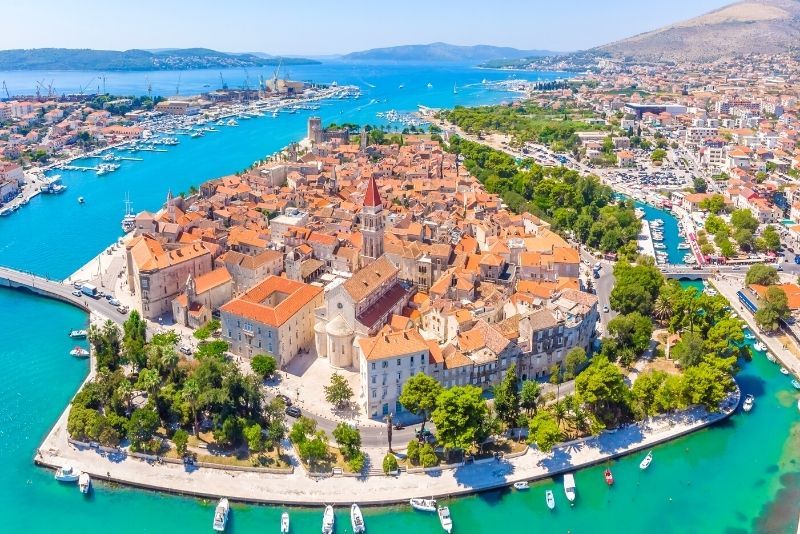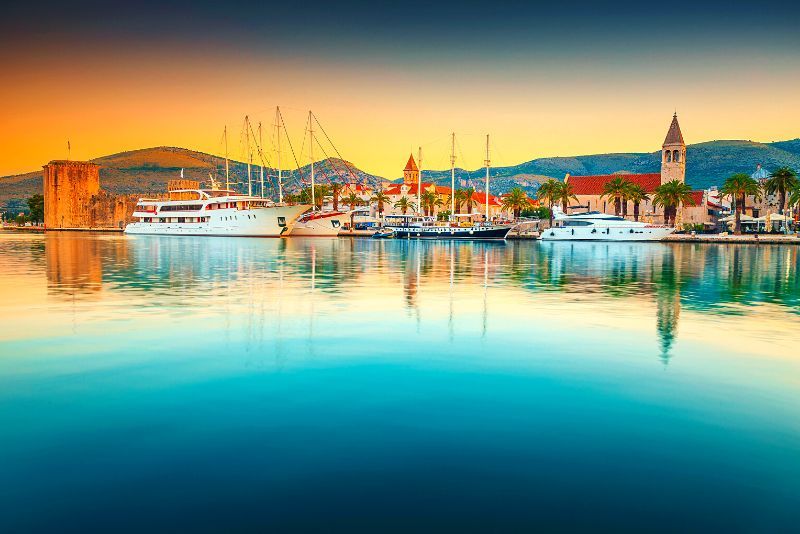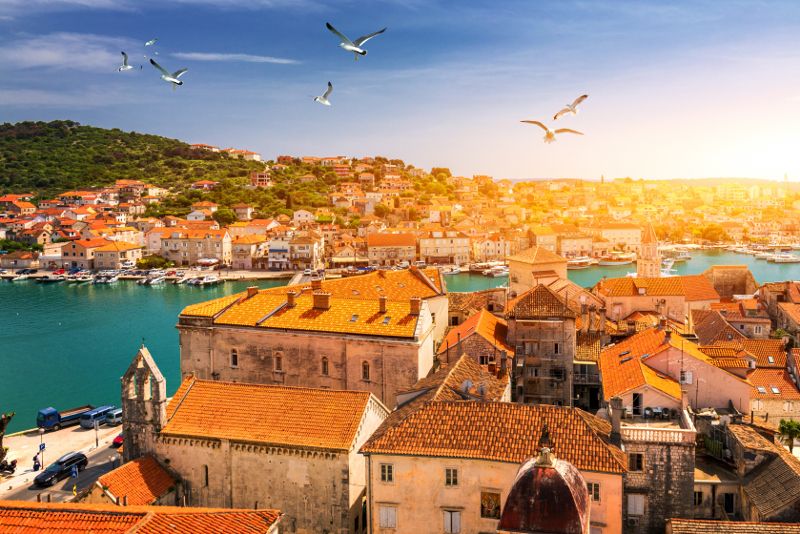Free Walking Tours in Trogir
Situated on an island just off the Dalmatian Coast, Trogir has been affectionately dubbed “Little Venice” for its charming cobblestone streets and spectacular Italian architecture.
Often overshadowed by neighboring Split, the destination is littered with ancient monuments and grand fortresses, and is surrounded by the sparkling waters of the Adriatic Sea.
Situated on an island just off the Dalmatian Coast, Trogir has been affectionately dubbed “Little Venice” for its charming cobblestone streets and spectacular Italian architecture.
Often overshadowed by neighboring Split, the destination is littered with ancient monuments and grand fortresses, and is surrounded by the sparkling waters of the Adriatic Sea.

(0/24) checking Musement...
Situated on an island just off the Dalmatian Coast, Trogir has been affectionately dubbed “Little Venice” for its charming cobblestone streets and spectacular Italian architecture.
Often overshadowed by neighboring Split, the destination is littered with ancient monuments and grand fortresses, and is surrounded by the sparkling waters of the Adriatic Sea.
Free walking tours in Trogir are the perfect way to delve into the city’s history, which stretches back all the way to the 3rd century B.C.

Here's all you need to know about free walking tours, one of the most engaging options for sightseeing tours in Trogir.
How do free walking tours work?
Free walking tours in Trogir have become increasingly popular in recent years as they provide tourists with an affordable and authentic way of experiencing this incredible city.
These tours are completely free to book and participate in, but it is encouraged that you tip your tour guide at the end of the tour. The amount you decide to tip is completely up to you.
How much should you tip?
When deciding how much to tip, think about the effort that your guide put into the tour and how much you enjoyed the tour overall.
Most tour participants tend to tip between US$10 and US$15 per person, but some people tip as much as US$50 for outstanding tours.
What are the best free walking tours in Trogir?
Free walking tours in Trogir

Free walking tours in Trogir tend to follow the same itinerary and are usually led by a knowledgeable resident. The benefit of this is that you’ll be able to see the destination through a locals’ eyes and learn insider facts that other tourists aren’t privy to.
These guides are well-versed in the history of the town and will provide you with fascinating tidbits of information as you hop between landmarks.
You’ll meet at Sjeverna Gradska Vrata — the 15th-century northern gate to the Old Town — where you’ll discover a statue of Trogir’s first bishop, Ivan Orsini.
Moving on, you’ll see the Trogir Town Museum, which houses a unique collection of artifacts spanning several time periods, including Greek relics from the 1st century B.C., such as ceramics and a relief. The Roman era is also represented here through a selection of items, such as helmet fragments and coins.
Discover the town’s crowning jewel — St Lawrence’s Cathedral — which was built using a fusion of Romanesque and Gothic architectural styles, and dedicated to the patron saint of schoolchildren. This religious monument was erected in replacement of an older cathedral, which was destroyed during a raid by the Saracens in the 12th century.
You’ll also stroll through the Old Town to explore the 13th-century Ćipiko Palace. Here, you’ll admire classic Gothic Venetian architecture and learn about the esteemed Ćipiko family who once ruled the town.
Another highlight of this free walking tour is the Togir City Loggia, which was designed by the renowned artist and architect, Ivan Meštrović, in the 13th century. Today, the site is used to house the city’s Ethnographic Museum, which showcases costumes, furniture and jewelry from across the region of Dalmatia.
Wander through Južna Gradska Vrata — the south gate of Trogir, which is decorated with Renaissance ornaments — to reach your final destination, Kamerlengo Castle.
This attraction was built in the 15th century, expanding upon the 14th-century Veriga Tower already situated here. The fortress was built by the Venetians during their rule of the coastline in an effort to deter Ottoman forces from attacking the town.
Alongside being used as a fortress, Kamerlengo Castle has also been used as a prison and military base over the centuries, before it was opened to the public as a tourist attraction in the 1970s.
While each free tour in Trogir has its own guide who will put their own spin on the experience and may lead you to the attractions in a different order, these are the typical destinations that are covered, regardless of which excursion you choose.
Once you reach your end location, you can expect to know a great deal about this town’s history and culture, and you’ll have a better understanding of which sites pique your interest. From there, you can revisit any spots you’d like to dive further into, such as museums, enabling you to suit your itinerary to your own personal tastes.
In which languages is it operated?
Free walking tours in Trogir typically operate in English. However, in some cases, you may find other European languages, such as German, being offered as well. This means that while they are open to a wide range of international tourists, these excursions are not suitable for everyone.
In instances where tours are catered to residents of different countries, you’ll find that there are different time slots available for each language. This means that you can simply select the excursion appropriate to your dialect and you won’t have to listen to a dual commentary as you roam the city streets.
You’ll also have greater opportunity to bond with other like-minded travelers who speak the same language as you.
As the popularity of these guided walks increases, the range of languages on offer may increase, making them available to more national and international travelers.
Where does it start?

Free walking tours in Trogir usually begin at an easy-to-reach landmark, such as the town’s historic north gate — Sjeverna Gradska Vrata. Trogir is home to a reliable network of public buses and boats, which makes navigating around the destination simple, and enjoyable.
However, those who are staying in Trogir will find that the easiest way to get around is on foot. While some of the town is accessible to vehicles, the Old Town is pedestrianized, which makes it an ideal destination for a walking tour.
Whether you’re staying in the town itself or are traveling in from neighboring destinations, such as Split, you’ll find it easy to reach the Old Town. You can find out the meeting point of each tour before booking so that you can plan your route and arrange any necessary transportation ahead of time. Upon arrival, you’ll usually find your guide wearing or holding an item that makes them easy to recognize.
It’s worth noting that the end point of free walking tours in Trogir is usually different from the starting point, which you may need to consider when arranging transportation.
How long does it last?
Free tours in Trogir tend to last between 1 and 1.5 hours. The city is compact meaning that you can pack a lot of sightseeing into a small timeframe.
While you shouldn’t expect to see all of Trogir’s attractions in this timeslot, you’ll be able to gain a thorough introduction to the destination, which will aid you in making the most of your vacation.
Is it wheelchair friendly?
While some free walking tours in Trogir are suitable for wheelchair users, the majority are not. You can consult the booking page in order to find out whether your chosen excursion is appropriate for all members of your party.
If not, those with limited mobility can choose from a plethora of other tours and outdoor activities in Trogir that are more accessible.
When is the best time to join a free walking tour in Trogir?
Should you book tickets online?
Booking free walking tours in Trogir online ensures your spot, as they are popular and get booked up very quickly. These tours also have limited spots available to ensure the quality of the tour— with some maximum capacities being limited to as few as 10 people.
Reserving your spot on a tour is completely free and can be done with a few simple clicks through the online booking platform. Arrive in the Trogir with your tour already booked and make the most out of your time.

